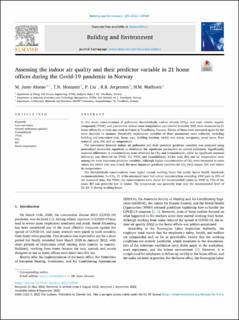| dc.description.abstract | In this study, concentrations of pollutants: formaldehyde, carbon dioxide (CO2), and total volatile organic compounds (TVOC) and parameters: indoor room temperature and relative humidity (RH) were measured in 21 home offices for at least one week in winter in Trondheim, Norway. Eleven of these were measured again for the same duration in summer. Potentially explanatory variables of these parameters were collected, including building and renovation year, house type, building location, trickle vent status, occupancy, wood stove, floor material, pets, RH, and air temperature.
The association between indoor air pollutants and their potential predictor variables was analyzed using generalized estimation equations to determine the significant parameters to control pollutants. Significantly seasonal differences in concentrations were observed for CO2 and formaldehyde, while no significant seasonal difference was observed for TVOC. For TVOC and formaldehyde, trickle vent, RH, and air temperature were among the most important predictor variables. Although higher concentrations of CO2 were measured in cases where the trickle vent was closed, the most important predictor variables for CO2 were season, RH, and indoor air temperature.
The formaldehyde concentrations were higher outside working hours but mostly below health thresholds recommendations; for CO2, 11 of the measured cases had indoor concentrations exceeding 1000 ppm in 10% of the measured time. For TVOC, the concentrations were above the recommended values by WHO in 73% of the cases. RH was generally low in winter. The temperature was generally kept over the recommended level of 22–24 ◦C during working hours. | en_US |

